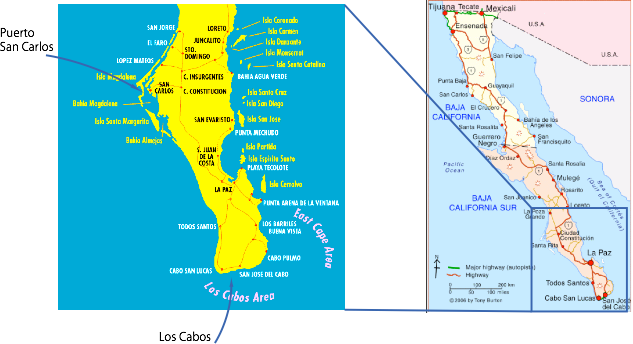Whale Touching( 2. 24 ~ 3.5, 2008)
My wife and I had a trip to Baja California Peninsula in Mexico to visit our relatives stayed at the resort. We joined whale watching boat cruising at the resort area. After that, I was eager to try watching whales more and visited a remote village located in the middle of the peninsula. I had unforgettable experience there - I touched a baby whale finally or experienced “Whale Touching.”
Please click the picture below to see the video of whales.
We went to Los Cabos, the resort area, by air from New York by way of Mexico City. Los Cabos is located at the southmost end of the Baja California Peninsula, that has a length of about 1600 km, one of the longest peninsula in the world.

The end of this peninsula is called “Land’s End”, as shown in the picture below that was taken from our airplane. In the picture, the upper sea is the Pacific Ocean while the lower the California Bay or the Cortes Sea. In the beaches close to the end, one at the Bay side is called “ Lovers Beach” while the other “Divorce Beach” at the Ocean side: much higher and violent waves are at the latter while the conditions are much more comfortable at the former. In the picture below, an army ship and a cruise ship are seen at the left and right lower, respectively.
Los Cabos is famous for its beautiful scenery and the picture of Land’s End is sometimes used for the sightseeing advertisement of Mexico.
At Los Cabos, we saw a lot of whales, 30 to 50 feet long, swimming in the pacific Ocean, with binoculars from land and also by joining “whale watching” boat cruising.

The whale watching conditions were much better in Puerto San Carlos, a small village located at 300km north east from Los Cabos. I went there by bus. It took two hours from Los Cabos to La Paz, the largest town in the peninsula. I stayed at the town one night. Next morning I departed the town and rode another bus to Puerto San Carlos for four and a half hours. The land along the highways is desert everywhere except towns, as shown in the picture below.

Puerto San Carlos is a tiny fishing village facing to a big bay, Bahia Magdalena. In late falls, gray whales migrate from the north seas, the Bering Sea and others, and arrive at several bays and lagoons in the Baja California Peninsula. Calves are born there. The whales leave there to the north from March to early June.
There are several hotels in Puerto San Carlos. I stayed at Motel Las Brisas, the closest from the bus stop. I walked around the village. There is only one ATM for getting cash at a remote place from the bus stop. Most people here only speak Spanish, not English, as it is very common in the countryside of Mexico. For traveling there, it is indispensable to speak some Spanish words and to have some courage and smiles.

The next day, we started cruising at 8:00 am in the Bahia Magdalena Bay. In the beginning, I enjoyed seeing a lot of birds, such as pelicans, sand pipers and vultures. After 30 minutes of cruising, we arrived at the opening area of the bay to the ocean. We watched a lot of whales swimming there. We do not necessarily need binoculars. I already had prepared a digital camera (Nikon D80), a camcoder (video camera) and an underwater camera. I believe a video camera must be the best tool for recording whales although mine had some troubles of batteries.
I tried an underwater camera when we found a calf and its mother swimming together. I failed to take pictures with it because they came so close to our boat that I was busy with watching and touching the calf finally! We returned to the shore at 11:30 am with much satisfaction.
I do hope I would try another whale watching in the near future - “whale touching” again or “whale kissing” if possible.

Page Top --- Please click Page Top to return to the top of this page.
Gray Whales
The above picture was taken at Los Cabos whereas the video at Puerto San Carlos.



